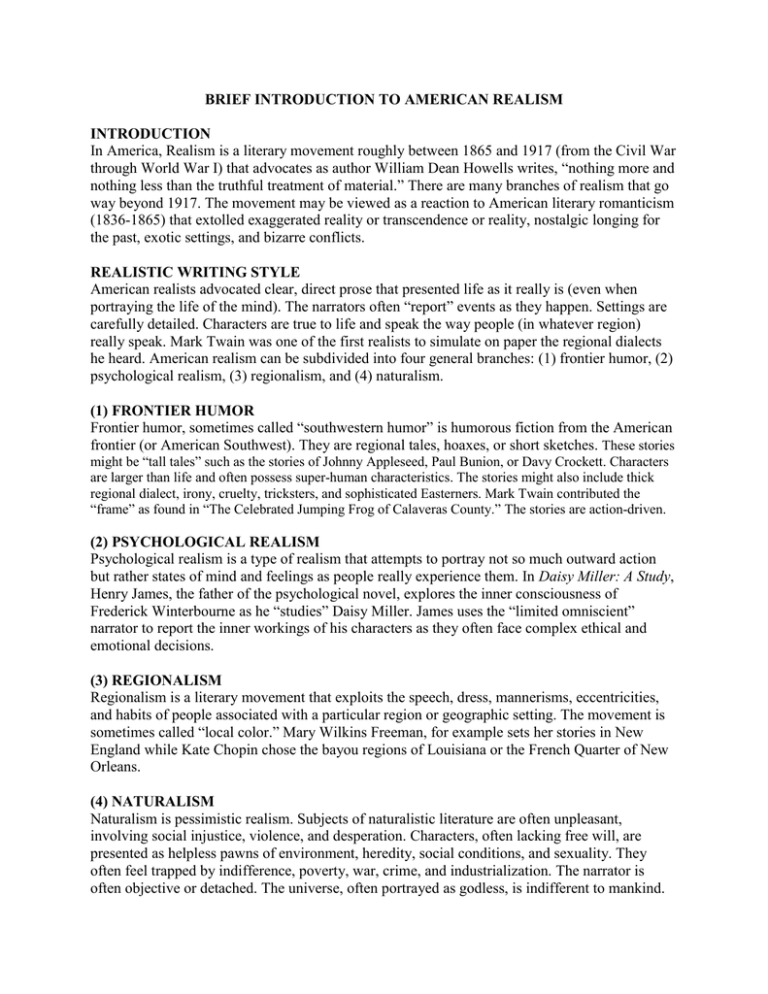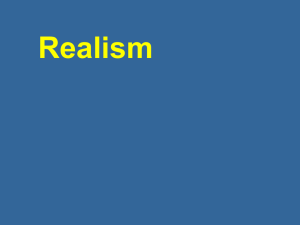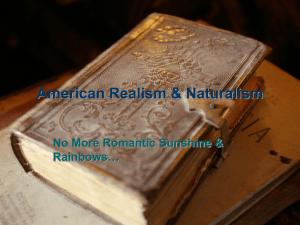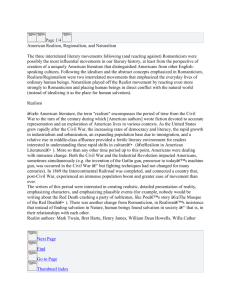AMERICAN REALISM.1.doc
advertisement

BRIEF INTRODUCTION TO AMERICAN REALISM INTRODUCTION In America, Realism is a literary movement roughly between 1865 and 1917 (from the Civil War through World War I) that advocates as author William Dean Howells writes, “nothing more and nothing less than the truthful treatment of material.” There are many branches of realism that go way beyond 1917. The movement may be viewed as a reaction to American literary romanticism (1836-1865) that extolled exaggerated reality or transcendence or reality, nostalgic longing for the past, exotic settings, and bizarre conflicts. REALISTIC WRITING STYLE American realists advocated clear, direct prose that presented life as it really is (even when portraying the life of the mind). The narrators often “report” events as they happen. Settings are carefully detailed. Characters are true to life and speak the way people (in whatever region) really speak. Mark Twain was one of the first realists to simulate on paper the regional dialects he heard. American realism can be subdivided into four general branches: (1) frontier humor, (2) psychological realism, (3) regionalism, and (4) naturalism. (1) FRONTIER HUMOR Frontier humor, sometimes called “southwestern humor” is humorous fiction from the American frontier (or American Southwest). They are regional tales, hoaxes, or short sketches. These stories might be “tall tales” such as the stories of Johnny Appleseed, Paul Bunion, or Davy Crockett. Characters are larger than life and often possess super-human characteristics. The stories might also include thick regional dialect, irony, cruelty, tricksters, and sophisticated Easterners. Mark Twain contributed the “frame” as found in “The Celebrated Jumping Frog of Calaveras County.” The stories are action-driven. (2) PSYCHOLOGICAL REALISM Psychological realism is a type of realism that attempts to portray not so much outward action but rather states of mind and feelings as people really experience them. In Daisy Miller: A Study, Henry James, the father of the psychological novel, explores the inner consciousness of Frederick Winterbourne as he “studies” Daisy Miller. James uses the “limited omniscient” narrator to report the inner workings of his characters as they often face complex ethical and emotional decisions. (3) REGIONALISM Regionalism is a literary movement that exploits the speech, dress, mannerisms, eccentricities, and habits of people associated with a particular region or geographic setting. The movement is sometimes called “local color.” Mary Wilkins Freeman, for example sets her stories in New England while Kate Chopin chose the bayou regions of Louisiana or the French Quarter of New Orleans. (4) NATURALISM Naturalism is pessimistic realism. Subjects of naturalistic literature are often unpleasant, involving social injustice, violence, and desperation. Characters, often lacking free will, are presented as helpless pawns of environment, heredity, social conditions, and sexuality. They often feel trapped by indifference, poverty, war, crime, and industrialization. The narrator is often objective or detached. The universe, often portrayed as godless, is indifferent to mankind.





